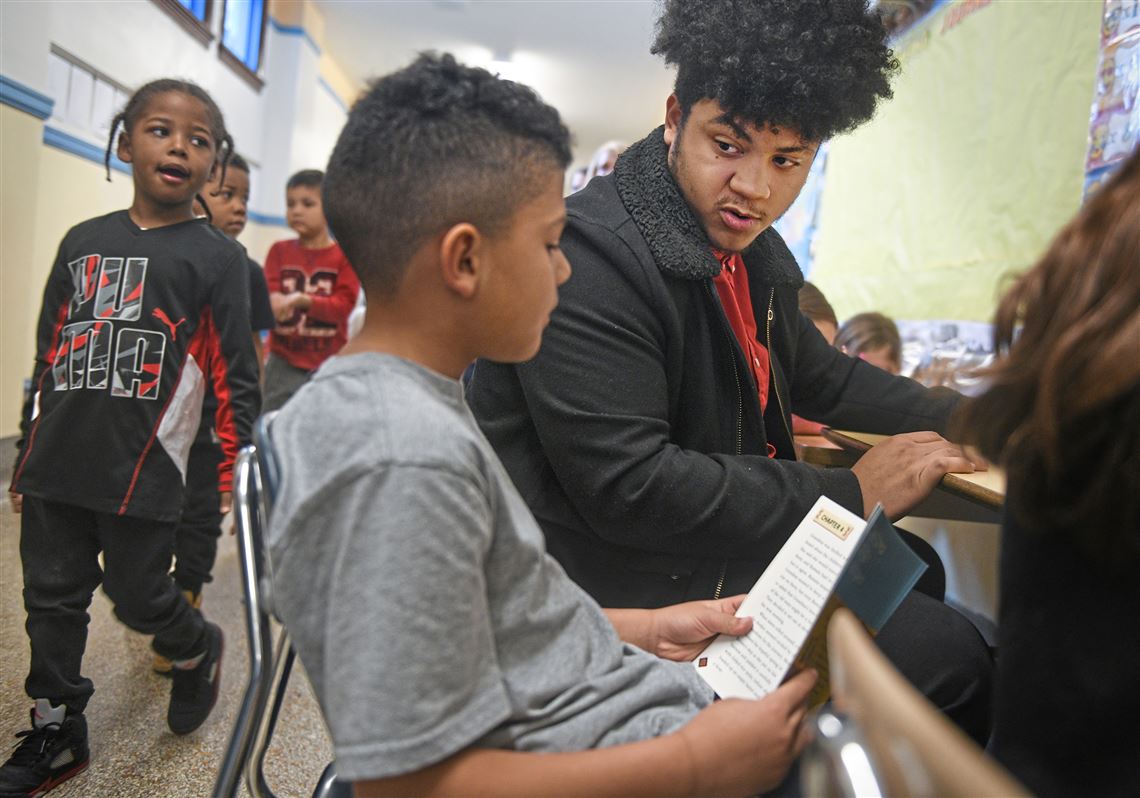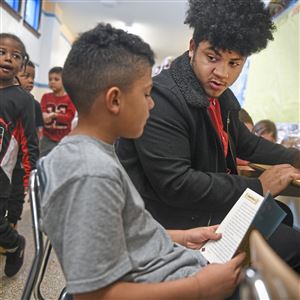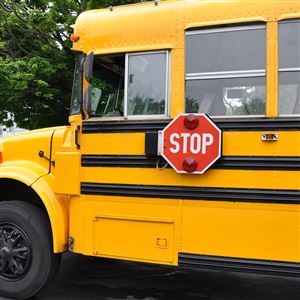Anthony Carrington spent every afternoon during the first semester of his senior year in high school working with third-grade students at Beechwood PreK-5 in Beechview.
The 17-year-old captain of the Pittsburgh Brashear football team worked individually with small groups of students in the school’s hallway. On a recent Thursday afternoon in December, he and five students sat at a small table outside the classroom, reading a short story and writing out summaries in workbooks.
“To have him in this room basically provides us with this reality that we never get,” said teacher Tabitha Geramita. Only a dozen of her 25 students are originally from the U.S., but she said the whole class loved the football star who visited them every day.
Anthony is one of 20 12th-grade students enrolled in the Pittsburgh school district’s teacher magnet program at Brashear. Students in the program take courses on teaching and classroom management alongside their usual academic courses, and in their senior year they spend a semester teaching actual classes and assisting other teachers throughout the district. This year, all of the seniors who will graduate from the program are African-American.
“No one really told me to be a teacher,” said Anthony, who plans to major in math at Youngstown State University.
He ultimately wants a career in sports analytics, but would also like to coach and teach music. Not enough of his teachers, he said, looked like him when he was growing up and he wants to be a role model for other young people.
Of Pittsburgh Public Schools’ more than 2,000 teachers in 2017-18, about 85 percent were white and most of them were women, according to district data. By comparison, 53 percent of the student population is black.
As in many school districts across the country, leaders in Pittsburgh Public Schools and other local districts want to hire more teachers that better reflect the diversity of their students. Research shows that teachers of color are beneficial for students of all races, and having a diverse school faculty can have positive effects in areas like student discipline, attendance and graduation rates.
But hiring more teachers of color is challenging even when school districts aren’t facing a shortage of teachers in general. Local school districts, colleges and universities are scrambling to find ways to recruit not just teachers of color, but educators who can work as substitutes, math and science teachers, ESL teachers and special education teachers.
“No one has the answer, but we’re trying to find strategies,” said Sue Rieg, dean’s associate for educator preparation in the Indiana University of Pennsylvania’s Department of Professional Studies in Education.
Statewide disparities
Research for Action, a Philadelphia-based education research group, released a report in April after reviewing Pennsylvania Department of Education data in 2016-17. The data show that only 4 percent of the state’s teachers are teachers of color, compared to 29 percent of students, meaning Pennsylvania has one of the highest disparities between teachers and students of color in the country.
About 96 percent of Allegheny County teachers in 2016-17 were white, data show. Pittsburgh Public Schools had the most diverse teacher workforce of the county’s 43 school districts, but only about 13 percent of teachers in PPS were black compared to more than half the student body. About 7 percent of the Wilkinsburg School District’s teachers were black, compared to 94 percent of its student population.
Two other districts with large black student populations, Woodland Hills (63 percent) and Gateway (24 percent) both reported about 5 percent of their teachers were black. In Penn Hills, where 63 percent of students are black, the district reported it had zero teachers of color.
Eighteen other districts in the county reported that they employed zero teachers of color that year.
Since 1996, the number of undergraduate education majors in Pennsylvania has declined by 55 percent, and the number of newly-issued in-state teaching certificates has dropped by 71 percent since 2009-10. According to Research for Action study, PDE data show that the number of black students majoring in education has dropped by 60 percent since 1996.
So in July, Gov. Tom Wolf’s office announced $2 million in grant funding for eight Pennsylvania universities to create residency programs to help prepare a new generation of teachers.
IUP was one of the recipients of the grant money, and will use it to expand residency programs for students on its urban teaching track and grow its partnerships with school districts. The university has partnered with PPS for years, and has students working in Pittsburgh schools, student-teaching and assisting as literacy coaches.
About 200 students graduate from IUP to become teachers each year, Ms. Rieg said. It used to be that the school would graduate more new teachers than there were available positions, but that trend has reversed over the years, she said.
IUP has been working hard to recruit more potential educators, and has even been encouraging its students and graduates to start identifying children as young as fourth-graders who have the leadership skills to make good teachers and start talking to them about whether they would want to be one when they grow up. Talking to children about the career early on could be especially helpful when it comes to recruiting people of color to the field.
“It's very non-scientific, it's just planting that seed,” Ms. Rieg said. “Children of color don't see a lot of teachers of color, so they don't have those role models to say, ‘I want to be like her or I want to be like him.’ It's a catch-22. They need to see more teachers of color being more successful.”
The social and economic climate surrounding teaching and concerns about school safety could be reasons why fewer people in general view teaching as a career, said Robert Harris, PPS’ chief of human resources.
The city school district over the years has expanded its “recruiting boundaries” and coordinated with historically black colleges and universities about open teaching positions. But even despite Pittsburgh’s competitive teacher salaries and low cost of living, teachers aren’t usually willing to relocate from another part of the country for their job, Mr. Harris said. The district can’t offer incentives or signing bonuses.
“The easier proposition is to grow your own,” he said.
Teaching magnet
The Brashear Teaching Magnet began in 1989 as the Langley Teaching Academy, and moved several years ago when Langley High School was closed.
Over the years the number of students enrolled in the program has fluctuated, but it has swelled to about 100 students across four grades this year, said Hannah McCarthy, who has led the program for 10 years. Included in that number are 49 African American girls and 35 African American boys.
The school district made a “big hire” in the early 1990s, and now that wave of teachers is preparing to retire, said Ms. McCarthy, who also is a vice president with the Pittsburgh Federation of Teachers. That surplus of soon-to-be open positions combined with the fact that fewer people are graduating college to become teachers means the district will have to scramble to fill those jobs.
“There’s nobody to take their place,” she said.
But the district is exploring several ways to fill those jobs with people the district already employs. Or with its own students.
The district is working on a Memorandum of Understanding that would allow graduates of the Brashear Teaching Magnet to come back and teach in Pittsburgh after they finish college, meet all the requirements and earn their certifications, leaders said. Some of them have expressed interest in teaching a variety of subjects and different grade levels, as well as working with kids in special education or English-learner classes, Ms. McCarthy said.
“It’s a nice mix,” she said. “You need all teachers. Any teacher that loves kids, we’ll take.”
And the district is exploring the possibility of working with some of its more than 400 paraprofessionals — many of whom have bachelor’s degrees or PDE certifications and already work in the classrooms — to certify to fill some of the open teaching positions.
That would not only help address the looming teacher shortage, but hiring from within the district, in theory, would mean the administration is hiring people who reflect the diversity of the school district.
Brian Glickman, Pittsburgh Public’s director of talent management, said there now are more black male students enrolled in the Brashear teaching program than the number of black males who graduated with their teacher certification in all of Pennsylvania two years ago.
“It’s a very common-sense approach to look at the students that we (already) serve,” he said.
Other Allegheny County school districts say they have been working hard to attract more educators and more diverse teachers, as well.
Linda Iverson, superintendent of the Wilkinsburg district, said open positions are advertised online through the Pennsylvania School Boards Association and websites like Monster, which has a section that allows employers to filter for minority candidates and which allows the district to compile a diverse pool of applicants, Ms. Iverson said.
“This is an area we are continually working to improve,” she wrote in an email.
James Harris, superintendent of the Woodland Hills district, said he is less concerned about the race of the teachers than he is that they understand the students they are teaching. He said that’s especially important in a district that serves a dozen municipalities.
“We have a broad range of various backgrounds and cultures that we support,” he said. “What we look for here are, one, that our staff understand what our kids and families go through every day. What holiday do they celebrate? What norms and traditions do they have and how do we communicate with those folks?”
Like other districts, Mr. Harris said Woodland Hills finds it more difficult to recruit science and math teachers, likely because people who graduate with degrees in math or science can make more money in other fields.
“I think coming down the road you’re going to see teachers working kind of like football and free agency,” he said.
With a teacher shortage, quality teachers are going to get multiple job offers. More and more school districts are advertising salary ranges so they can compete with neighboring districts who are all vying to hire the same people, Mr. Harris said. But that’s still a challenge for most districts, because they are bound by collective bargaining agreements.
Still, he’s happy to talk up the teaching profession — teachers get summers and snow days off and get to go to prom once a year, he joked.
Creating positive relationships between students and teachers helps students of all races realize that could be a possible career path.
People who may not have had the best relationships and experiences with teachers in schools may not want to be that,” Mr. Harris said. “It's very hard to want to be like someone that you may not like or haven't had the best experience with. For us, we try to make sure that our students have the most positive experience possible so that they want to come back and not only work with the community but with the school district.”
Elizabeth Behrman: Lbehrman@post-gazette.com, 412-263-1590 or @Ebehrman on Twitter.
First Published: December 30, 2018, 4:22 a.m.
Updated: December 30, 2018, 4:22 a.m.























